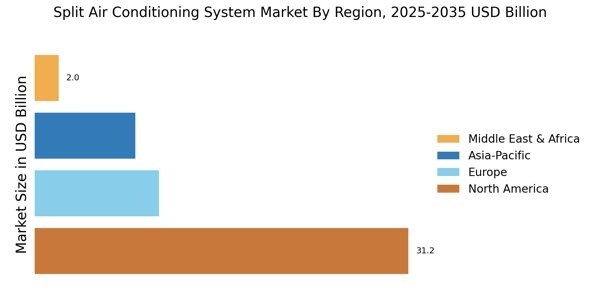Urbanization and Population Growth
Urbanization continues to be a significant driver for the Split Air Conditioning System Market. As more individuals migrate to urban areas, the demand for residential and commercial cooling solutions escalates. The United Nations projects that by 2050, nearly 68% of the world’s population will reside in urban areas, which could lead to increased housing and infrastructure development. Consequently, this urban expansion necessitates the installation of air conditioning systems to ensure comfort in densely populated environments. The Split Air Conditioning System Market is likely to benefit from this trend, as new constructions often incorporate modern cooling technologies to meet the needs of urban dwellers.
Government Regulations and Incentives
Government regulations aimed at improving energy efficiency and reducing carbon emissions are influencing the Split Air Conditioning System Market. Many countries are implementing stricter energy efficiency standards for air conditioning units, which encourages manufacturers to innovate and produce more efficient systems. Additionally, various governments are offering incentives for consumers to upgrade to energy-efficient models, further stimulating market growth. For instance, tax rebates and subsidies for energy-efficient appliances are becoming more common, making it financially attractive for consumers to invest in modern air conditioning systems. This regulatory environment is likely to foster a more competitive landscape within the Split Air Conditioning System Market.
Rising Temperatures and Climate Change
The increasing The Split Air Conditioning System Industry. As average temperatures rise, consumers are more likely to invest in air conditioning systems to maintain comfortable indoor environments. According to recent data, the demand for air conditioning units has surged, with a projected growth rate of approximately 5% annually. This trend suggests that as climate conditions become more extreme, the reliance on efficient cooling solutions will intensify, thereby propelling the Split Air Conditioning System Market forward. Furthermore, regions that previously had mild climates are now experiencing hotter summers, leading to a broader customer base seeking air conditioning solutions.
Increased Awareness of Indoor Air Quality
The growing awareness of indoor air quality (IAQ) is emerging as a crucial driver for the Split Air Conditioning System Market. Consumers are becoming more conscious of the health implications associated with poor air quality, leading to a heightened demand for air conditioning systems that incorporate advanced filtration and purification technologies. Research indicates that indoor air can be significantly more polluted than outdoor air, prompting individuals to seek solutions that enhance IAQ. As a result, manufacturers are increasingly focusing on developing air conditioning systems that not only cool but also improve air quality. This trend is likely to propel the Split Air Conditioning System Market as consumers prioritize health and well-being in their purchasing decisions.
Technological Advancements in HVAC Systems
Technological advancements in heating, ventilation, and air conditioning (HVAC) systems are transforming the Split Air Conditioning System Market. Innovations such as inverter technology, which enhances energy efficiency, and smart thermostats that allow for remote control and monitoring, are becoming increasingly prevalent. These advancements not only improve user experience but also contribute to energy savings, which is a growing concern among consumers. The market for smart air conditioning systems is expected to grow significantly, with estimates suggesting a compound annual growth rate of over 10% in the coming years. This technological evolution indicates a shift towards more sophisticated and efficient cooling solutions within the Split Air Conditioning System Market.


















Leave a Comment